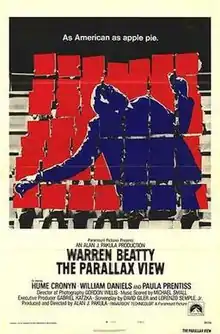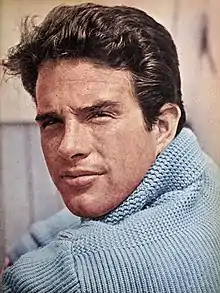| The Parallax View | |
|---|---|
 Theatrical release poster | |
| Directed by | Alan J. Pakula |
| Screenplay by | David Giler Lorenzo Semple Jr. |
| Based on | The Parallax View by Loren Singer |
| Produced by | Alan J. Pakula |
| Starring | |
| Cinematography | Gordon Willis |
| Edited by | John W. Wheeler |
| Music by | Michael Small |
Production companies |
|
| Distributed by | Paramount Pictures |
Release date |
|
Running time | 102 minutes |
| Country | United States |
| Language | English |
The Parallax View is a 1974 American political thriller film starring Warren Beatty, with Hume Cronyn, William Daniels and Paula Prentiss in support. Produced and directed by Alan J. Pakula, its screenplay was by David Giler and Lorenzo Semple Jr., based on the 1970 novel by Loren Singer.[1] The story concerns a reporter's investigation into a secretive organization, the Parallax Corporation, whose business is political assassination.
Plot
TV journalist Lee Carter witnesses the assassination of U.S. senator and presidential candidate Charles Carroll atop the Seattle Space Needle. The apparent shooter, a waiter, is chased to his death, while the actual killer, disguised as a waiter, dissolves into the chaos. An investigation by an official panel attributes the killing to a single suspect who acted alone.
Three years later, Carter visits ex-boyfriend Joe Frady, an investigative newspaper reporter. She tells him that six witnesses to the assassination have since died and she fears she will be next. Soon after, Carter is found dead of a suspected drug overdose.
Guilty over disregarding Carter's pleas, and suspicious of her sudden death, Frady goes to the small town of Salmontail, to probe the drowning death of Judge Arthur Bridges, another witness to Carroll's assassination. The local sheriff, Wicker, offers Frady his assistance and escorts him to the dam where Bridges met his fate to investigate. As its floodgates open, Wicker pulls his gun on Frady.
After a desperate struggle in which the sheriff drowns, Frady escapes in the sheriff's squad car and races to the sheriff’s home. There, Frady uncovers documents from the Parallax Corporation, an organization recruiting "security" operatives. Later, Frady contacts a local psychology professor, who assesses a Parallax personality test taken from Wicker's desk. He deems it a profiling exam to identify homicidal psychopaths.
Austin Tucker, who was an aide to Carroll and a witness to his assassination, agrees to meet Frady. He reveals there have been two attempts on his life since Carroll's murder. Shortly after, a bomb goes off on his sailboat, killing Tucker and his bodyguard. Frady is also presumed dead by the authorities, but swims ashore and tells his editor he will use his apparent death as cover for applying to Parallax under an alias.
Days later, Parallax official Jack Younger contacts Frady to tell him Parallax has accepted him for training. On his first visit to the corporation's Los Angeles headquarters, Frady's reactions are measured as he watches a montage of disturbingly-edited still pictures that juxtapose pro- and anti-American attitudes. After departing the offices, Frady trails a Parallax operative to Los Angeles International Airport, where the man sends a bomb aboard a passenger jet in the checked baggage.
Frady boards the plane and spots a United States senator who, like the ill-fated Carroll, is now considering running for president. Frady secretly passes on a note to a stewardess about the bomb, and the jet returns safely to Los Angeles and is evacuated just before it explodes.
Back at his apartment, Frady is confronted by Younger about his alias being a fake, but mollifies him with a pre-planned cover story. Later, at the newspaper office, Frady's editor listens to a recording of the conversation between Frady and Younger. He then places it in an envelope with other recordings. That same evening, he is killed by the same Parallax assassin and the recordings vanish.
Frady returns to Parallax headquarters and follows the same Parallax operative to a huge exhibit hall in the Los Angeles Convention Center, where a dress rehearsal is being held for a political rally for yet another presidential aspirant, Senator George Hammond. Frady chases the operative and watches from the hall's catwalks as Hammond drives toward the exit in a golf cart, only to be fatally shot by an unseen sniper.
Frady is spotted on the catwalk and falsely identified as the shooter. Realizing too late he has been set up as a patsy, he attempts to flee, but is killed by Parallax security men. Six months later, another official investigative committee reports that Frady was a paranoid lone gunman who killed Hammond out of a misguided sense of patriotism.
Cast

- Warren Beatty as Joseph Frady
- Paula Prentiss as Lee Carter
- Hume Cronyn as Bill Rintels
- William Daniels as Austin Tucker
- Kenneth Mars as former FBI agent Will Turner
- Walter McGinn as Jack Younger
- Kelly Thordsen as Sheriff L. D. Wicker
- Jim Davis as Senator George Hammond
- Bill McKinney as Parallax assassin
- Stacy Keach Sr. as Commission Spokesman #1
- Anthony Zerbe as Professor Nelson Schwartzkopf (Uncredited)
- William Jordan as Tucker's aide
- Edward Winter as Senator Jameson
- Chuck Waters as Thomas Richard Linder
- Earl Hindman as Deputy Red
- William Joyce as Senator Charles Carroll
- Jo Ann Harris as Chrissy, Frady's girl
- Doria Cook-Nelson as Gale from Salmontail
- Ford Rainey as Commission spokesman #2
- Richard Bull as Parallax goon
Production
Development
The film is based on a novel by Loren Singer. While the novel followed witnesses of John F. Kennedy's assassination who were subsequently killed, the screenplay shifted them to have seen an assassination more like that of Robert F. Kennedy.[2] Robert Towne did an uncredited rewrite on the screenplay.[3]
.jpg.webp)
Cinematography
Frady is often filmed from great distances, suggesting that he is being watched.[2]
Montage
Most of the images used in the assassin training montage were of anonymous figures or important historical figures, featuring among others Richard Nixon, Adolf Hitler, Pope John XXIII, and Lee Harvey Oswald (in the picture taken moments after his shooting). The montage also uses a drawing by Jack Kirby of the Marvel Comics character Thor. It juxtaposes the concepts of LOVE, MOTHER, FATHER, HOME, ENEMY, and ME. The montage "captures the confusion of post-Kennedy America" by demonstrating the decay of values and longstanding traditions.[4]
It has been compared to the brainwashing scene in the 1971 Stanley Kubrick film A Clockwork Orange.[5][4]
Critical reception
At the time of its release, The Parallax View received mixed reactions from critics. Roger Ebert gave the film three out of four stars. While Beatty offered a good performance Ebert said the actor was not called upon to exercise his full talents, and Ebert also noted similarities to the 1973 film Executive Action, but said Parallax was "a better use of similar material, however, because it tries to entertain instead of staying behind to argue."[6] In his review for The New York Times, Vincent Canby wrote, "Neither Mr. Pakula nor his screenwriters, David Giler and Lorenzo Semple, Jr., display the wit that Alfred Hitchcock might have used to give the tale importance transcending immediate plausibility. The moviemakers have, instead, treated their central idea so soberly that they sabotage credulity."[7] Joseph Kanon of The Atlantic found the film's subject pertinent: "what gives the movie its real force is the way its menace keeps absorbing material from contemporary life."[8]
Time magazine's Richard Schickel wrote, "We would probably be better off rethinking—or better yet, not thinking about—the whole dismal business, if only to put an end to ugly and dramatically unsatisfying products like The Parallax View."[9]
In 2006, Entertainment Weekly critic Chris Nashawaty wrote, "The Parallax View is a mother of a thriller... and Beatty, always an underrated actor thanks (or no thanks) to his off-screen rep as a Hollywood lothario, gives a hell of a performance in a career that's been full of them."[10]
Alexander Kaplan at Film Score Monthly notes, "Beatty brought his relaxed, low-key charm[,] making his character’s fate even more shocking, while the supporting cast provided ... memorable performances, including Paula Prentiss’s heartbreakingly terrified reporter[.] ... Pakula observed that Frady 'imagines the most bizarre kind of plots, (but) is destroyed by a truth worse than anything he could have imagined.' The film’s ending ... suggests that Parallax may have been onto Frady the whole time, another subversion of his heroic status. Even the hero’s name is unheroic, 'Joe Frady' suggesting a mocking mixture of Dragnet’s Joe Friday and the schoolyard taunt [']fraidy cat.'"[11]
The motion picture won the Critics Award at the Avoriaz Film Festival (France) and was nominated for the Edgar Allan Poe Award for Best Motion Picture. Gordon Willis won the Award for Best Cinematography from the National Society of Film Critics (USA).
The film's reception has been more positive in recent years. On Rotten Tomatoes the film has an approval rating of 88% based on reviews from 40 critics. The site's consensus states "The Parallax View blends deft direction from Alan J. Pakula and a charismatic Warren Beatty performance to create a paranoid political thriller that stands with the genre's best."[12] On Metacritic the film has a score of 65% based on reviews from 12 critics.[13]
Reviewing films depicting political assassination conspiracies for The Guardian, director Alex Cox labelled the film the "best JFK conspiracy movie".[14] Film critic Matt Zoller Seitz has called the film, "a damn near perfect movie".[15]
See also
References
- ↑ Singer, Loren (1970), The Parallax View. New York: Dell, ISBN 1401069029
- 1 2 Kirshner, Jonathan (July 27, 2016). "In the Dark". Slate. Archived from the original on October 31, 2020. Retrieved September 20, 2020.
- ↑ Lefcourt, Peter; Shapiro, Laura (2009-02-18). The First Time I Got Paid For It: Writers' Tales From The Hollywood Trenches. Hachette Books. ISBN 978-0-7867-4522-7. Archived from the original on 2023-01-21. Retrieved 2022-07-29.
- 1 2 Semley, John (November 20, 2013). "The Best Scene in the Best Conspiracy Thriller Ever". Esquire. Archived from the original on December 5, 2020. Retrieved September 20, 2020.
- ↑ Smith, Kyle (August 14, 2020). "The Political Noir for the Age of Assassination". National Review. Archived from the original on September 24, 2020. Retrieved September 20, 2020.
- ↑ Ebert, Roger (June 14, 1974). "The Parallax View". Chicago Sun-Times. Archived from the original on November 12, 2008. Retrieved October 1, 2009.
- ↑ Canby, Vincent (June 20, 1974). "The Parallax View". The New York Times. Archived from the original on January 21, 2023. Retrieved October 1, 2009.
- ↑ Simon, Art (July 21, 2017). "In The Parallax View, Conspiracy Goes All the Way to the Top—and Beyond". Slate. Archived from the original on October 31, 2020. Retrieved September 20, 2020.
- ↑ Schickel, Richard (July 8, 1974). "Paranoid Thriller". Time. Archived from the original on December 22, 2008. Retrieved October 1, 2009.
- ↑ Nashawaty, Chris (July 12, 2006). "The Parallax View and other great Beatty roles". Entertainment Weekly. Archived from the original on October 13, 2022. Retrieved October 7, 2022.
- ↑ "The Parallax View". Film Score Monthly. 2010. Retrieved May 29, 2023.
- ↑ "The Parallax View". Rotten Tomatoes. Archived from the original on September 27, 2020. Retrieved May 19, 2022.
- ↑ "The Parallax View". Metacritic. Archived from the original on 2020-11-15. Retrieved 2021-01-01.
- ↑ Cox, Alex (November 19, 2013). "The Parallax View: a JFK conspiracy film that gets it right". The Guardian. London. Archived from the original on October 31, 2020. Retrieved September 20, 2020.
- ↑ @mattzollerseitz (March 8, 2013). "THE PARALLAX VIEW (1974). Dir: Alan J. Pakula. DP: Gordon Willis. A damn near perfect movie" (Tweet) – via Twitter.
External links
- The Parallax View at IMDb
- The Parallax View at AllMovie
- DVD Savant review of the montage
- The Parallax View: Dark Towers an essay by Nathan Heller at the Criterion Collection